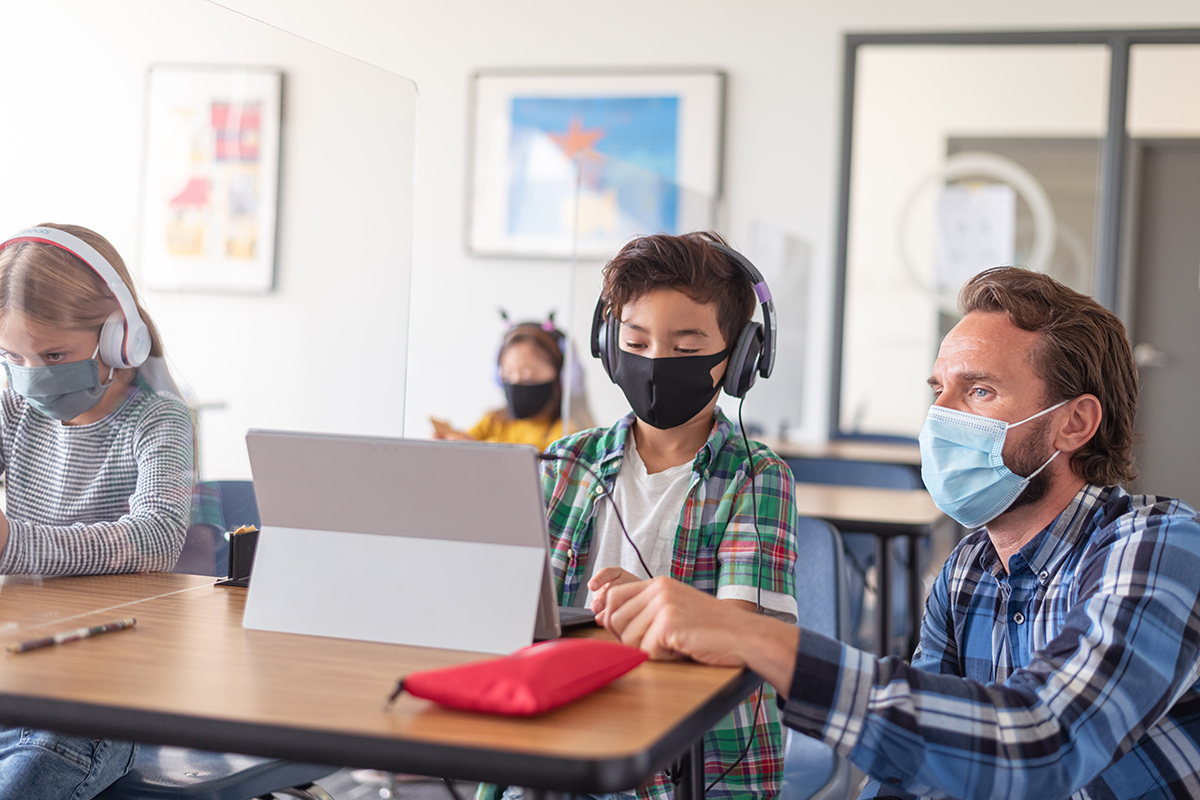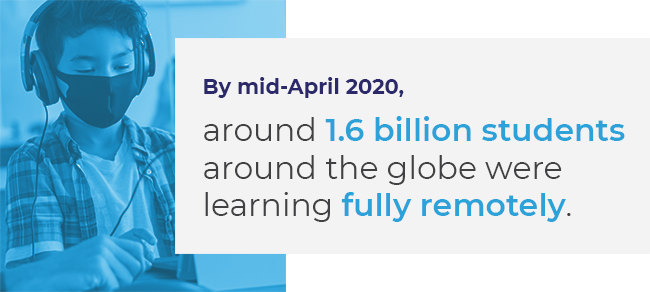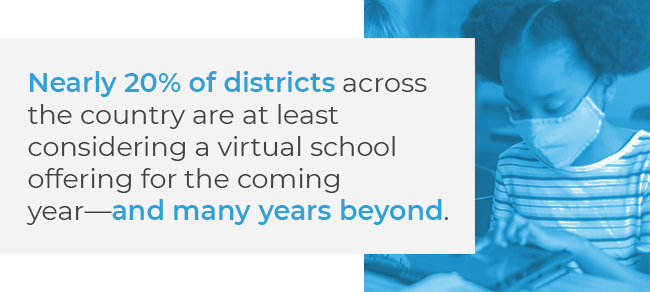
June 1, 2021 8:00 am
COVID-19 forced a revolution in digital education — and opened a path to a more connected future.
It has been just over a year since schools across the globe were forced to shift to digital learning environments and new ways of teaching and learning. The experience was disastrous for some, imperfect for many, and preferable for others.
There’s no denying the past 12 months represent a revolution in education that will fundamentally impact how educators, students and parents think about learning going forward.
Though the COVID-19 pandemic massively disrupted learning and left a host of challenges in its wake, it also catalyzed a breakthrough in digital learning that has been decades in the making.
As we close out this school year and plan for the next, the education community has critical decisions to make, knowing there’s no going back to the “way things were” before the pandemic. Our collective focus must be on taking everything we’ve learned from this year — the good and the bad — to build a more connected, collaborative, data-led future for education.

Before the pandemic, personalized and adaptive learning experiences were widely available, but not widely adopted. A shortage of devices for K-12 students and a widespread belief that the technology was better suited for supplemental learning prevented most students from benefiting from a truly connected digital learning experience.
The past year has seen an explosion in digital learning in North America and around the world. By mid-April 2020, UNESCO estimates that around 1.6 billion students around the globe were learning fully remotely. To accommodate this sudden shift, districts across the country ramped up their device distribution. In March of this year, Education Week reported 90% of middle and high schools are providing one device for every student. In contrast to a 2018 EdWeek Market Brief report, where only 40% of district IT directors said they had a 1:1 student to computer ratio.

Nearly every teacher in America has been experimenting with new technology, and we have more data than ever before on how that technology can best support teachers and students and enable learning breakthroughs. Beyond these insights, many districts and schools now have a much more robust infrastructure for online learning.
In a non-pandemic world, it would have taken years or even decades to reach this level of adoption, device distribution, and real-world data. All of these developments have created a once-in-a-generation opportunity to reimagine learning.
As with any sudden, widespread adoption of technology, there were plenty of growing pains. Through our work partnering with over 5,000 school districts and supporting over 10 million students across the country, we shared a front row seat to many of those challenges.
COVID disruptions exposed and exacerbated the digital divide and inequities of our education system. Initial studies suggest millions of students were without access to the internet, the right devices, and family support — falling further behind.
A recent study we conducted with Oliver Wyman (2020) reported that educators from across the country suggests that more than 50% of their students are performing below grade level. This staggering reality is compounded by millions of students who must be supported to catch up academically, address their social and emotional well-being and even process trauma, something that educators say will take several years.
Despite the heroic efforts of educators, many students, parents, and teachers have come away from this experience with varied views of the benefits of digital learning. What we know for sure is that technology cannot replace teachers. Teachers are the center of student learning. And when paired with the right resources and support, students feel more supported, and achieve higher levels of learning and overall growth.
Even in the face of challenges, everyone involved in education has seen enough to realize the potential value of digital learning.
When utilized effectively, digital learning solutions can dramatically improve the learning process. They can help support the relationship between student and teacher and drive learning breakthroughs, in part by:
Used as designed, digital learning technology frees up teachers to thoughtfully plan lessons, focus on social and emotional needs, and develop deeper relationships with their students. The goal is to let the technology do what it does best, so our teachers can do more of what they do best.
“In a non-pandemic world, it would have taken years or even decades to reach this level of adoption, device distribution, and real-world data. All of these developments have created a once-in-a-generation opportunity to reimagine learning.”
For the vast majority of students who will be returning to in-classroom learning, we expect digital learning to remain a fundamental part of their education. Many districts have seen enough value that, according to a recent RAND Corporation survey, nearly 20% of districts across the country are at least considering a virtual school offering for the coming year — and many years beyond.
We’ve seen how purposefully integrated digital learning tools can complement classroom learning and ignite breakthroughs for students.
So the question before us is not if but how best to integrate digital learning into the classroom?
As U.S. Education Secretary Dr. Miguel Cardona recently asked “What do we want our system to look like?” Rather than going back to the pre-pandemic status quo, we imagine a collaborative, connected, data-led future for learning in which teachers, curricula, and technology work together to ignite learning breakthroughs for students.
Each student is on their own individual learning journey, and instruction should be personalized and differentiated for them. A 2019 study by The Abdul Latif Jameel Poverty Action Lab (J-PAL) showed that educational software can effectively overcome traditional classroom challenges like “large class sizes with a wide range of learning levels,” which can “make it hard for teachers to personalize instruction.” Just as products like Waze design a route for drivers in real time — accounting for traffic and other roadblocks and delivering the driver to their destination as efficiently as possible — teachers should be able to pick students up wherever they are in their learning journey and take them where they need to go. While the destination may be the same (3rd grade reading proficiency or the successful completion of Algebra 1), each path will be different depending on the learner and her environment. Personalized and adaptive technology empowers teachers to identify and overcome those roadblocks without losing precious instructional time. Teachers can then scaffold up in areas where a student needs assistance or provide more rigorous material that encourages her to stretch, building confidence and enabling her to perform at her maximum potential.
We must rethink our approach to assessment, which has long been used to sort and label kids in unproductive ways. An overwhelming majority of teachers (81%) believe students spend too much time taking district- and/or state-mandated tests. (Center of Education Policy) Adaptive technology can improve the efficiency and fairness of formative assessments by reducing bias and freeing up valuable instructional time. And this type of assessment enables more personalized learning: when teachers have real-time data on which students need specialized attention and instruction, they can better tailor content to each students’ unique educational journey.
To address unfinished learning, districts from Los Angeles to Atlanta are considering adding summer sessions, lengthening the school day or even the school year. But after a particularly draining year, some parents are pushing back on plans to adjust the academic calendar. And for those students who were already behind, we simply can’t make up all the time that has been lost. We must consider the essential skills that are prerequisites for grade-level learning — prioritizing the most important literacy and mathematics skills to succeed. Digital learning companies, together with teachers and administrators, need to collaborate to create plans that help students get to grade level and beyond. Rather than focusing on acceleration — which doesn’t make sense for students who may already be several grade levels behind — we should be coming together to develop on-ramps to help students reach their potential.

Implementing this technology in the classroom with fidelity requires leadership and continued professional learning opportunities for educators and district leaders. And the digital learning industry needs to be true partners in making that happen.
When it comes to digital learning, there isn’t just a light at the end of the tunnel of a truly difficult year — there’s a very bright future for our students and our educators. I hope we have the courage to embrace it and collaboratively create new learning experiences that enable every student to grow and thrive.

Vice Chairman and Chief Strategy Officer, Imagine Learning
Sari began her career as a mathematics teacher but soon thought of much bigger ways to impact students. Recognizing that technology could greatly transform the way students learn, she made a career move into education technology and has been working to leverage technology to help students, teachers, schools, and districts ever since.
Sari joined Imagine Learning in 2011 and has held leadership positions at successful educational publishing and learning technology companies, including Kaplan, McGraw-Hill, Houghton Mifflin, and Everyday Learning Corporation. “I knew that I could fulfill my vision to combine technology with research on learning to make education truly student-centered.”